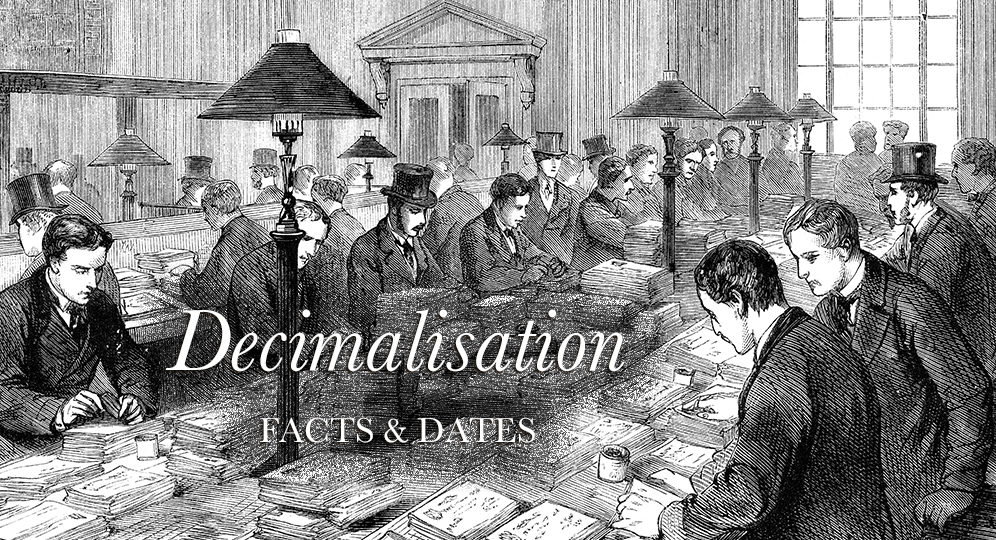Decimalisation: Facts and Dates

by Dr Sati McKenzie
The issue of decimalisation is a running theme throughout the Palliser novels. Plantagenet Palliser strives to simplify the currency and make the country ‘count in tens’, but to no avail. In reality the subject of decimalisation was discussed in the Victorian period, but it was not until 1971 that the currency became decimal.
19th Century
- The discussion started early in the 19th century. February 1824 saw one of the earliest debates in parliament, when Sir John Wrottesley’s motion on the subject was defeated. A complicating factor was the use of gold & silver for coins. The face value of the coin was less than the intrinsic value of the precious metal. In those days, one ounce of gold was worth 99s (£4.95), now it costs about £1500. Platinum was often used in forgeries – instead of silver or as a core with a coating of gold. Originally it was proposed to have 1000 units to the pound (instead of 960 farthings). It was later changed to 100 as inflation became an issue.
- The Decimal Association was founded in 1841 in support of both decimalisation of currency and use of the metric system for weights and measures. These had been in use in France and US since the 1790’s. The CGS system (centimetre, gram, second) was adopted in scientific circles, a precursor to the SI system introduced in 1960.
- In 1849, the silver florin (worth 2 shillings, tenth of a pound) was minted, a step towards decimalisation – the new 10p. In 1887, the double florin appeared (worth 4 shillings), equivalent to the new 20p.
Fast Forward to the 20th century
- 1960’s – many commonwealth countries Australia, NZ and South Africa had gone decimal. It was generally agreed that the changeover was necessary; it would simplify accounting, business and trade by a considerable degree. It would save a great deal of schooling in arithmetic (is that really an advantage?); but the UK government hesitated over the complications of changeover. The Halsbury Committee of enquiry into decimalisation was set up in 1961. This reported in 1963 and proposed the pound as the basic unit. Other alternatives were considered: 10 or 5 shillings as the unit (instead of the pound); other bases than decimal – octal, hexadecimal (compatible with computers), duodecimal – still has a following!
- 1966 March – final agreement reached in parliament (Wilson-Callaghan). There was debate about what the hundredth part was to be called, finally settled for new pence, which became the ‘new p’, then simply ‘p’. The 1/2p coin was also to be included. There were competitions to find designs for the new coins. Some of these were minted in advance of the switchover date.
- 1968: 5p and 10p coins were introduced; these were the same size and worth the same amount as the one and two shilling coins.
- May 1969 saw the passing of the Decimal Currency Act; a new 50p coin was introduced to replace the old 10 bob (shilling) note.
- 1969-71: The Decimal Currency Board (DCB) was set up chaired by William Fiske, running a public information campaign in the two years prior to the switchover. The half-crown (2/6, or two shillings and sixpence) and old half-penny were withdrawn ahead of the transition for the sake of convenience. There were some delays – caused by a postal strike early in 1971, but it finally happened on Monday 15 February 1971, known as Decimal Day.
- The banks had been shut for several working days to allow for essential activities. Shops were opened as ‘old currency’ and ‘new currency.’ It had been expected that the transition would take some two years, but in fact it took a matter of weeks – sufficient for the Decimal Currency Board to be wound up in 1971.
- The old sixpence worth 2.5p survived till 1980 for sentimental reasons. Pre-decimal pennies are still in use in one part of London where they have a vital role. They are used to adjust the timing of the pendulum of the Big Ben, in the Clock Tower of the Palace of Westminster.
The whole process took ten years after the committee was set up. Perhaps the Duke of Bungay was optimistic.
Illustration: Bank of England (Accountants Bank Note Office) “Illustrierte Welt” 1872